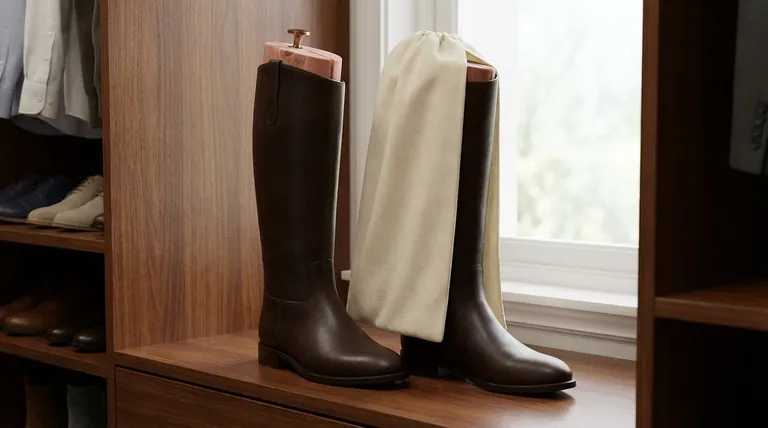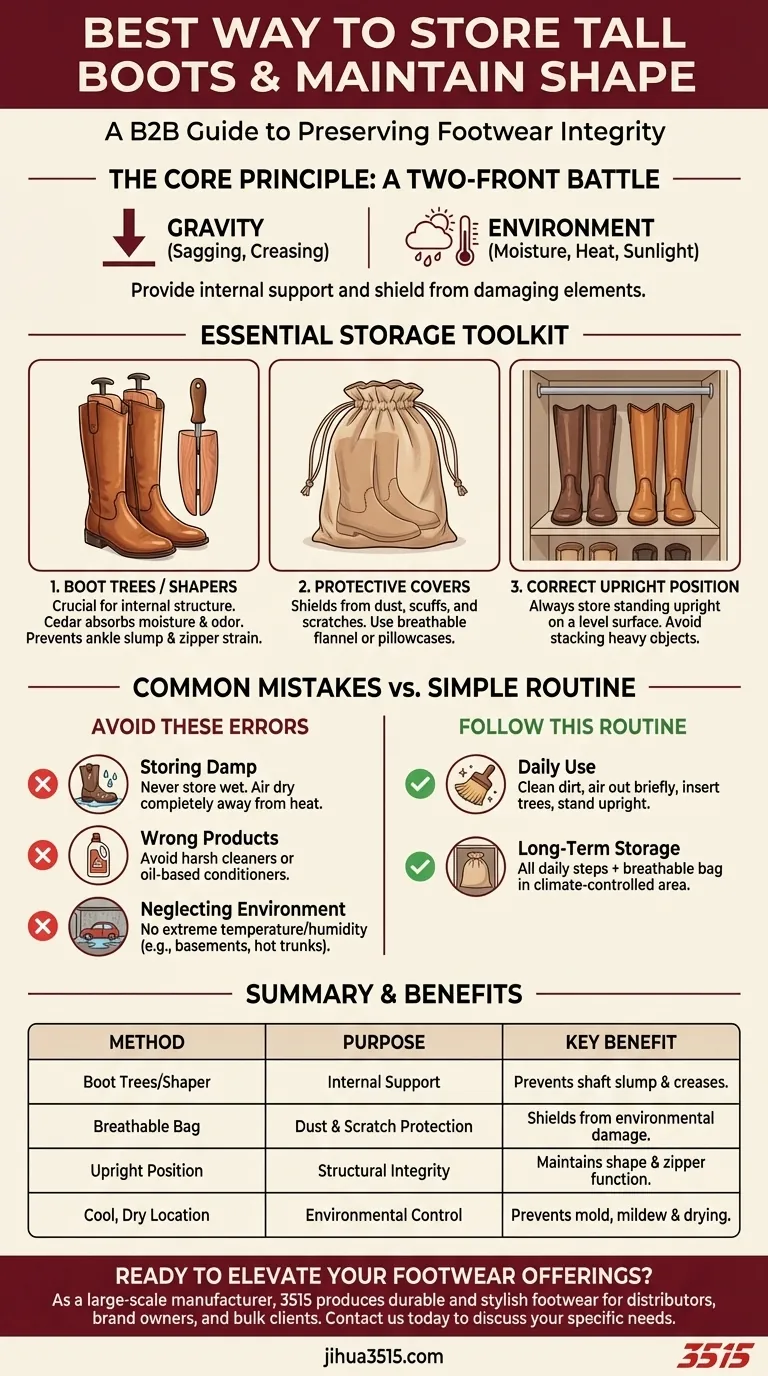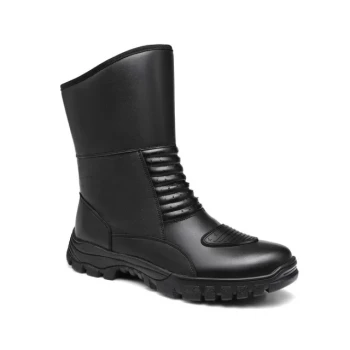To maintain the shape of tall boots, the best method is to store them upright with boot trees or shapers inserted into the shaft. This prevents the ankle from slumping, which protects both the leather from creasing and the zipper from strain. For complete protection, place them in a cool, dry location away from direct sunlight and cover them with a breathable bag.
The core principle of proper boot storage is a two-front battle against gravity and the environment. You must provide internal support to counteract sagging while simultaneously shielding the leather from damaging moisture, heat, and sunlight.

Why Proper Storage is Non-Negotiable
For any owner of quality tall boots, storage is not a passive activity but an essential part of maintenance. Neglecting it is the fastest way to degrade your investment, leading to permanent damage that cannot be easily repaired.
Fighting Gravity: Preserving Structural Integrity
The defining feature of a tall boot is its upright shaft. Without internal support, gravity will cause the shaft to fold and collapse at the ankle.
This constant slump creates deep, permanent creases in the leather. More critically, it puts uneven and prolonged stress on the zipper, which is often the first point of failure on a boot.
Controlling the Environment: Preventing Material Breakdown
Leather is a natural material that reacts to its surroundings. Storing boots in a damp or humid area, like a basement, invites mold and mildew.
Conversely, exposure to direct sunlight or a heat source like a radiator will dry out the leather's natural oils. This causes it to become brittle, fade in color, and eventually crack.
Your Essential Storage Toolkit
A few simple tools are all you need to create the ideal storage conditions and preserve your boots for years to come.
Boot Trees: The First Line of Defense
A boot tree or shaper is the single most important tool for maintaining your boot's form. It provides the necessary internal structure to keep the shaft straight and uncreased.
Cedar boot trees are particularly effective, as they not only hold the shape but also absorb residual moisture and odor from the leather. If you don't have dedicated boot trees, stuffing the shaft firmly with newspaper or rolled-up magazines is a viable alternative.
Protective Covers: Shielding from Dust and Scuffs
Placing your boots in flannel drawstring sacks or old pillowcases provides a crucial layer of protection.
This simple step prevents dust from settling on the leather and protects the finish from accidental scuffs and scratches from other items in your closet.
Correct Positioning: Upright and Unburdened
Always store your boots standing upright on a level surface. Avoid laying them on their side or, worse, piling them in a heap.
Never stack heavy objects on top of your boots. The external pressure will crush their structure and lead to misshapen leather that is difficult to restore.
Common Mistakes That Ruin Tall Boots
Knowing what to do is only half the battle. Actively avoiding these common storage mistakes is just as critical for protecting your boots.
Storing Them While Damp
Never store boots immediately after wearing them in wet conditions. Always allow them to air dry completely, away from any direct heat source. Inserting a boot tree into a damp boot traps moisture, creating a perfect environment for mold.
Using the Wrong Care Products
Before storing your boots, especially for a long season, be sure they are clean. However, avoid using harsh products not intended for fine leather, such as saddle soap or oil-based tack conditioners, which can strip the boot's protective finish.
Neglecting the Storage Environment
Leaving boots in a car trunk, a damp basement, or next to a sunny window is a recipe for disaster. The extreme temperature and humidity fluctuations in these environments will rapidly degrade the leather.
A Simple Storage Routine for Longevity
A consistent routine is the key to protecting your investment. The right approach depends on how frequently you use your boots.
- If your primary focus is daily use: Clean any dirt off, allow the boots to air out briefly, insert boot trees, and stand them upright in your closet.
- If your primary focus is long-term storage: Perform the daily steps, but also place the boots inside a breathable flannel bag in a climate-controlled part of your home.
- If you are breaking in new boots: You can use a small block of wood at the ankle while in storage to gently stretch the leather for extra room.
By actively managing their shape and environment, you ensure your boots remain a functional and valuable asset for years to come.
Summary Table:
| Storage Method | Purpose | Key Benefit |
|---|---|---|
| Boot Trees/Shaper | Internal Support | Prevents shaft slumping and creases |
| Breathable Bag | Dust & Scratch Protection | Shields leather from environmental damage |
| Upright Position | Structural Integrity | Maintains boot shape and zipper function |
| Cool, Dry Location | Environmental Control | Prevents mold, mildew, and leather drying |
Ready to elevate your footwear offerings? As a large-scale manufacturer, 3515 produces a comprehensive range of durable and stylish footwear for distributors, brand owners, and bulk clients. Our production capabilities encompass all types of shoes and boots, ensuring top quality and reliable supply. Contact us today to discuss how we can meet your specific needs and deliver exceptional value to your customers.
Visual Guide

Related Products
- Customizable Anti-Smash Safety Boots for Wholesale & Private Label Manufacturing
- Custom Wholesale Leather Safety Boots Direct Factory Manufacturing
- Premium High-Cut Waterproof Safety Boots Manufacturing & Wholesale Solutions
- Premium Wholesale Waterproof Safety Boots High Performance Protection for Industrial Markets
- Durable Goodyear Welt Leather Work Boots for Wholesale & Private Label
People Also Ask
- Are safety shoes worth it? The Critical Investment in Workplace Safety & Foot Health
- What types of toe protection are available in safety Wellington boots? Steel vs. Composite Toe Caps
- What are the essential features all work boots should have regardless of gender? Non-Negotiable Safety & Support
- Why is manufacturer diversity and inclusion important in work boot design? For Superior Fit, Safety & Comfort
- Is safety-toe as good as steel toe? Choose the Right Protection for Your Job



















